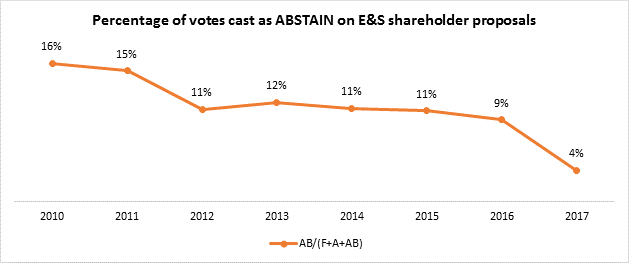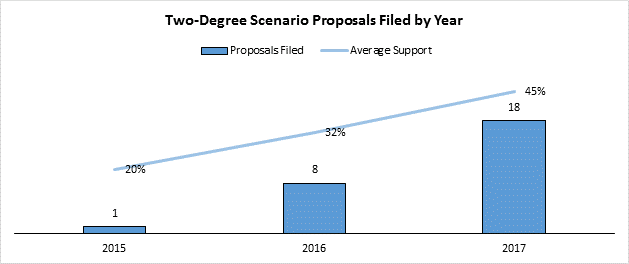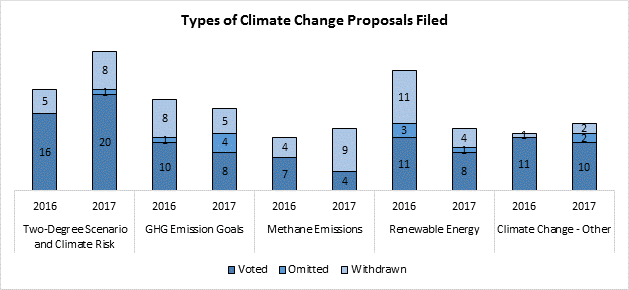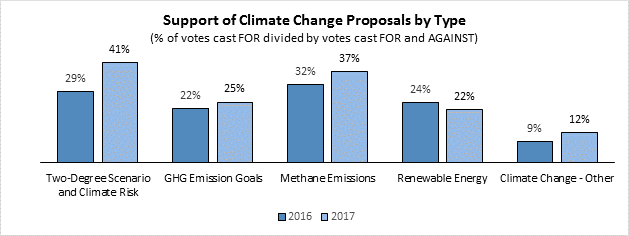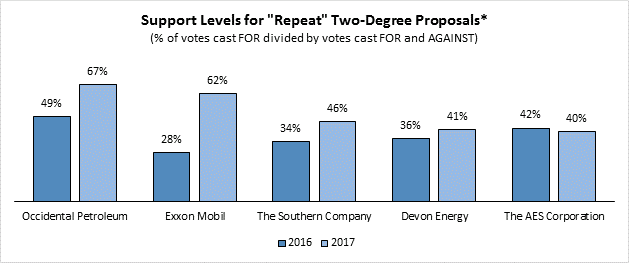Cristina Banahan is an Advisor with ISS Corporate Solutions. This post is based on an publication by ISS, the parent company of ISS Corporate Solutions.
[Last week], BlackRock CEO Larry Fink released his annual letter to CEOs, an important signpost for investor priorities in the coming year. In his letter, titled “A Sense of Purpose,” Mr. Fink says:
“In order to make engagement with shareholders as productive as possible, companies must be able to describe their strategy for long-term growth.
The statement of long-term strategy is essential to understanding a company’s actions and policies, its preparation for potential challenges, and the context of its shorter-term decisions. Your company’s strategy must articulate a path to achieve financial performance. To sustain that performance, however, you must also understand the societal impact of your business as well as the ways that broad, structural trends—from slow wage growth to rising automation to climate change [emphasis added]—affect your potential for growth.”
As investors such as BlackRock look deeper into strategy and climate change issues (and call them out specifically in their shareholder engagement activities), they are increasingly becoming more active in their support for calls for increased transparency and disclosure regarding portfolio companies’ preparedness for climate change. And, when shareholder proposals are filed calling for increased transparency and disclosure, support rates are increasing.
In 2018, these types of proposals will likely feature even more prominently on the proxy landscape. ISS is aware of 59 filed proposals related to climate change for 2018 proxy season, including 15 two-degree scenario proposals (one already withdrawn—at Exxon Mobil) and seven proposals on climate change risk management. The two-degree scenario proposals were filed by ten different main filers (not counting any co-filers), which shows that these filings are not the result of a single campaign—as is often the case with environmental and social proposals—but the outcome of a widespread initiative.
Source: ISS Shareholder Proponent Database
Background of Two-Degree Proposals
Two-degree scenario proposals are an evolution of shareholder requests for disclosure on how companies manage potential climate-related risks. Unlike former proposal types that sought for general disclosure on addressing climate change risks, the two-degree scenario proposals focus on two degrees Celsius above pre-industrial levels as the uppermost limit in global temperatures tolerable to the environment, as substantiated by the Intergovernmental Panel on Climate Change’s scientific findings. In the United Nations Framework Convention on Climate Change’s 2015 Paris Agreement, the international community pledged to adopt policies and programs to curb carbon emissions in order to reach the two-degree target. Shareholder proponents anticipate that, in order to meet the two-degree goal, governments will have to increase regulation, and the private sector will have to accelerate innovation. In particular, proponents seek disclosure on how companies are preparing for climate-related risks and how they account for these risks in their capital investment decisions. While shareholders argue that planning for a two-degree scenario is necessary for protecting the long-term value of their investments, corporate boards have broadly responded by saying that this risk analysis is conducted as part of the regular course of business. The financial risks, however, appear too high for shareholders to ignore; hence, proponents continued to push for greater disclosure.
Proponents of two-degree proposals include asset owners, SRI funds, foundations, and shareholder advocacy groups each with a long history of filing shareholder proposals. Notable filers include the New York State Common Retirement Fund, the As You Sow Foundation, Mercy Investment Services, Wespath Investment Management and many others. On some occasions, large asset owners like city and state pension funds brought forward proposals using the full weight of their shares. For example, in 2017, the New York State Common Retirement Fund owned 11.6 million shares valued at approximately $1 billion before bringing the two-degree proposal at ExxonMobil. On other occasions, proponents seeking additional disclosure were small asset owners with minor stakes in the company that barely met the minimum ownership requirement to file a proposal. It is common for multiple proponents to join forces and co-file proposals.
Changing Shareholder Attitudes
Marking a departure from previous trends, recent studies indicate that ESG and climate change considerations are gaining traction among investors. EY’s 2017 investor survey on ESG issues found that investors routinely included ESG considerations as part of their investment decisions. Shareholders are not only paying closer attention to non-financial indicators, but they are also more likely to take action on such information. According to the study, the percentage of respondents who consider nonfinancial disclosures to be seldom material or have no financial impact dropped from 60% in 2013 to 16% in 2016. Furthermore, the report found that, when faced with disclosures of risk or history of poor environmental performance, 15 percent of investors responded that they would rule out the investment immediately, while 76 percent would reconsider the investment. Similarly, 8 percent of investors responded that they would rule out an investment with disclosures involving risk from climate change, while 71 percent would reconsider the investment.
Actual voting data seems to confirm the study; many shareholders are coming off the sidelines on environmental and social shareholder proposals. The trend of abstain votes has been downward over the past eight years, and took a sharp decrease in 2017.
Source: ISS Voting Analytics
Asset owners have pioneered efforts in climate change not only as filers of shareholder proposals but also as public advocates for risk management and transparency. Asset owners comprise the majority of the 409 signatories to the Global Investor Statement on Climate Change, representing more than $24 trillion in assets. Participating asset owners view climate change engagement as a part of their fiduciary duty to their beneficiaries. As signatories, they have committed to identifying low-carbon opportunities, assessing climate-related risk, and working with corporate issuers on disclosure practices. Some asset owners have gone further, identifying inaction on climate change as a failure to recognize the energy sector’s vulnerability to an imminent paradigm shift. Moreover, a few public funds look at divestment from fossil fuel assets as the ultimate way of addressing climate risk concerns in their portfolio. New York City recently announced its decision to divest its pension funds of about $5 billion in fossil fuel investments, while New York State is reviewing a similar initiative upon the proposal of Governor Cuomo. The Norwegian government is also considering a recent proposal by its central bank to divest fossil fuel stocks from its $1 trillion sovereign wealth fund. Some in the asset owner community, including New York State Comptroller Thomas DiNapoli, argue that pension funds can achieve more on climate change through shareholder power in fossil fuel investments instead of divesting.
In the asset management community, we have seen an even more significant shift towards greater climate risk awareness in recent years. Asset managers’ changes in attitude have emerged in the form policy updates and a closer look at sectors perceived to be particularly vulnerable. This trend becomes evident even among investors who were historically less supportive of environmental proposals. For example, in 2017, Fidelity Investments updated its proxy voting policy guidelines stating that, although it generally supports management on environmental proposals, it would consider supporting shareholders where the burden on the company would be low, and where disclosure would provide meaningful information. Specifically, Fidelity highlighted areas where it might support proposals to include disclosure on renewable energy and environmental impact. In turn, Blackrock, included climate risk disclosure as one of its main engagement priorities for 2017-2018: “Consistent disclosure of standards would enhance understanding of the impact of climate change on individual companies, sectors and investment strategies.”
A change in policy does not suggest a monolithic approach to always supporting climate resolutions, since institutional shareholders generally apply a case-by-case approach. For example, institutions often vote differently at companies that appear to have similar climate risk profiles. Company-specific factors, such as current disclosure practices, overall performance, and future disclosure commitments may typically drive the voting decision. Improved company practice as a result of engagement may even lead to the withdrawal of proposals, as was the case with Chevron in 2017 in response to the company’s release of its climate risk management report.
The success of two-degree proposals has been limited to the energy sector for the time being, while shareholder activists in other industries focus on different kinds climate change proposals. Two-degree proponents have been particularly interested in sectors perceived to be vulnerable to climate change regulation and renewable energy innovation, i.e., utilities, oil and gas. However, proposals requesting general climate change action have extended beyond the energy sector to encompass finance, consumer goods, natural resources, technology, telecommunications, and healthcare. Climate change proposals for non-energy sectors mostly focus on setting GHG emissions goals, renewable energy targets, and changing proxy voting guidelines at asset managers. Excluding the energy sector, the next three industries to receive the most climate change proposals are the financial, consumer discretion, and consumer staples sectors.
Two-degree proposals gaining momentum
The number of filings and support levels for two-degree proposals demonstrate the aforementioned shift in shareholder preferences. In 2015, there was a single two-degree proposal on ballot at Noble Energy, which received 20% support. In 2016, there were seven proposals, including those at Chevron, Exxon and Occidental Petroleum with support levels close to 40% of votes cast. The trend continued in 2017, as the number of filed proposals increased to eighteen, and average support levels exceeded 40% of the vote, with three proposals receiving majority support: ExxonMobil, Occidental Petroleum and PPL Corporation.
Source: ISS Voting Analytics
Two-degree and climate change risk proposals have outpaced the number of filings for all other climate change proposals. Proposals for greenhouse gas (“GHG”) emission goals and renewable energy continue to be filed in large numbers. Other types of climate change proposals include: requests for review of proxy guidelines, nomination of directors with environmental experience, increase of return on capital in light climate change risks, among others.
Source: ISS Voting Analytics
Two-degree and climate risk proposals not only outpaced other types of climate change proposals in the number of proposals filed, but also outpaced them in levels of support. Two-degree and climate risk proposals received almost twice the amount of support of the next two most frequently filed proposals—GHG Emission Goals and Renewable Energy. Although Methane Emissions also fared well in levels of support, the number of voted proposals in this category was limited.
Source: ISS Voting Analytics
While three climate risk proposals received majority support, several more fell just short. For instance, shareholder proposals at AES, FirstEnergy, Southern Company, Devon Energy, and Dominion Energy all received more than 40 percent support in 2017.
*Covers only companies that received proposals both years and the proposals went to a vote.
Source: ISS Voting Analytics
The Path Ahead
Early indications are that the number of shareholder proposals on climate change issues will remain strong in 2018—perhaps even a record-breaking year. And with evolving voting policies at influential investors and some strong investor statements confirming a stronger dedication to climate change issues, it seems that those proposals will be met with increasing support at the ballot.
Through 2017, climate change risk proposals in the fossil fuel and utility sectors have received significant support, but proposals outside those sectors have not received the same energetic reception. 2018 may be the year where shareholder perceptions regarding the importance of climate change risk will extend outside the energy industry.
Perhaps the largest question remaining is: How open will companies be to negotiating climate change strategy, transparency and disclosure before the shareholder proposals reach the ballot? This could be the year where shareholder-initiated engagement efforts on climate change ramp up significantly; the number of filed and withdrawn proposals over proxy season 2018, and subsequent enhanced disclosures, may tell an interesting story.
 Print
Print
